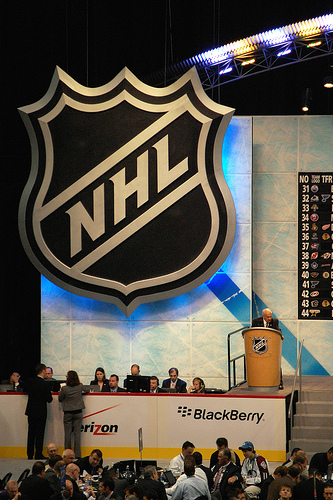By Karen Aney (The Cascade) – Email
Print Edition: January 9, 2013
We hoped, we prayed, we screamed – and it paid off. In case you’ve been hiding under a rock, the NHL is back. In typical professional sports fashion, many rumours abound about what the terms of the deal reached was. As of press time, the contracts have not been written, but the main agreed upon points are in the stats box on the right-hand side of this page. The length of the season has also not been determined. It will either be 48 or 50 games long, beginning on January 15 or 19. Either way, the seasons will be played entirely within each team’s conference.
What it means for the Canucks
It means good things. Their biggest challenge is the Minnesota Wild, who signed Zach Parise and Ryan Suter to identical $98 million, 13-year contracts over the summer. The Team USA teammates were arguably the biggest trade stories of the off-season, and are skilled enough to be game changers for the Wild.
The Edmonton Oilers are another threat in our conference, as they have “the kids” – including the AHL’s two top scorers, Jordan Eberle (51 points) and Justin Schultz (48 points). During the last lock-out, Ryan Kesler, Alex Burrows and Kevin Bieksa spent their season in the AHL – given the benefit it had for their play individually and as a team, this time spent at the AHL level together can only mean good things for the media darlings of Edmonton.
Age will be a huge factor
The 1994-1995 lockout resulted in a 48-game season. In that season, the youngest of the top 10 scorers were 22 and 23 – and they were Eric Lindros and Jaromir Jagr, who tied for first place. Ron Francis, in fifth place at 32, Paul Coffey, in seventh place at 34, and Mark Messier, in 10th place at 34, represent anomalies: their presence in the top 10 rankings indicates that this could very likely be a season for the veterans. The oldest team in the league right now, based on the average age, is the New Jersey Devils at 29.34. The Canucks clock in at ninth, with an average age of 27.961. Granted, the grueling schedule—less travel time but more games—could lead to fatigue and a higher rate of injuries, but this is the time for established players to shine.
Benefits for the East
The travel time for teams in the eastern conference, as with regular seasons, is going to be severely reduced. In the 2011-2012 season, the Canucks travelled 75,359 kilometers. The Bruins, in comparison, travelled 54,347 kilometers. That being said, the Canucks had only two trips where they played a single game – the Boston Bruins had 11. This number is sure to go up for the Canucks this year, given the reduced amount of teams to play. Because the distance between arenas is so much greater in the West, it’s going to be a definite factor. As we all know, the Stanley Cup comes down to the East versus the West – increased travel makes it just a little bit harder to bring the cup back to the west coast.
Attendance in question
Based on the 1994-1995 lockout, it means good things. The NHL announced at the end of that season that attendance rose 3.5 per cent. However, the Canucks saw 1388 fewer people at their games. This could stem from a number of factors: it could be the calibre of team Vancouver saw that year, or it could have been the level of bitterness fans in Vancouver—arguably one of the most passionate markets—felt at the lockout.
The thing to remember is that every single game will count. There are no post-Christmas games to mail in. If a player gets suspended for calling his ex-girlfriend “sloppy seconds” it will seriously affect a large portion of the season. Each and every game will matter for the rest of the season – as such, we’ll likely continue to see sellouts in Vancouver this year.
The Gary Bettman effect
The end of the 1994-1995 lockout—and Bettman’s first year as NHL Commissioner—saw the migration of two Canadian teams south of the border. The original Winnipeg Jets, who moved to Phoenix, are slated to be moved again. The former Quebec Nordiques—now the Colorado Avalanche—have fared much better, but these were drastic moves that beg the question: what’s next?


